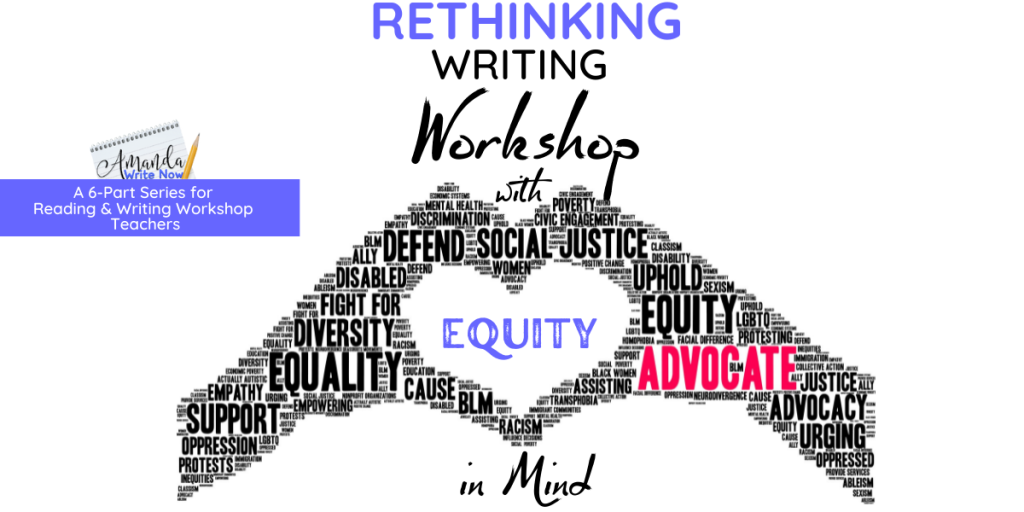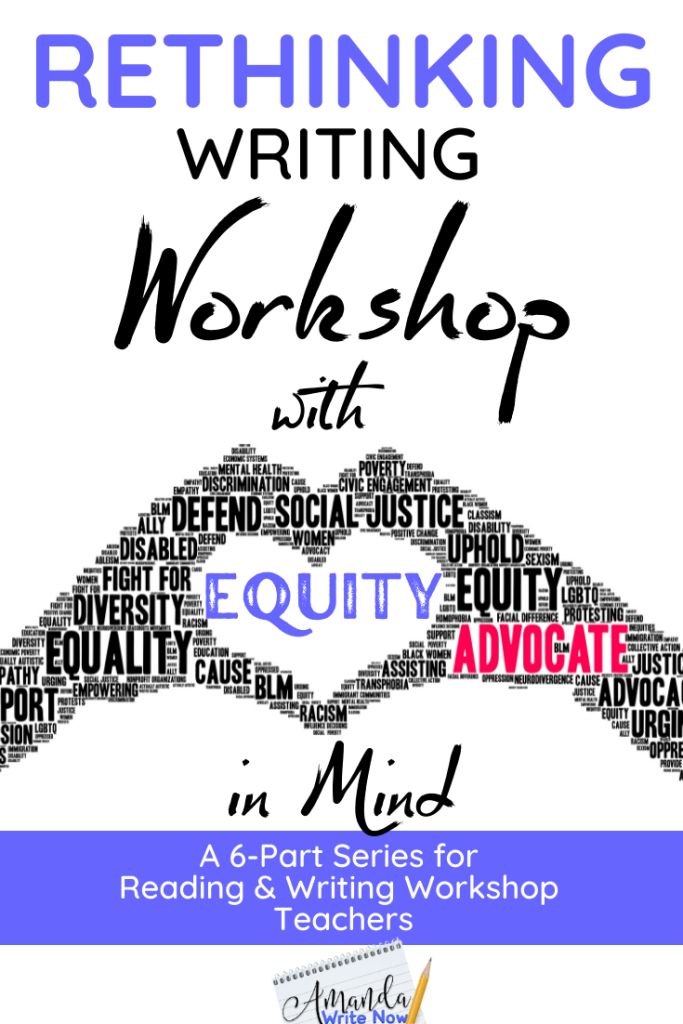
Amanda Write Now · 56. Rethinking Writing Workshop With Equity In Mind
Part 1: Rethinking Writing Workshop with Equity in Mind
Part 2: Rethinking Reading Workshop with Equity in Mind
Part 3: Rethinking Conferencing with Equity in Mind
Part 4: Rethinking Unit Design with Equity in Mind
Part 5: Rethinking Writing Assessment with Equity in Mind
Part 6: Rethinking Elementary and Secondary Reading Instruction and Assessment
In this six part series I will outline how I’m rethinking the workshop classroom with an equity lens. But, first of all, we need to define workshop and equity. Here is my very brief definition of both…
Workshop– a method of teaching that empowers students to become readers and writers in and outside of the classroom. This method of teaching involves a system wherein students work toward publishing pieces of writing and developing identities as readers by choosing the books they are interested in. Workshop also prioritizes developing a supportive community of readers and writers.
Equity-the act of treating people fairly. This is not to be confused with equality which is treating people equally. Our students are all unique and have different needs, so treating them all equally is just not possible, but treating them fairly and with their individual needs in mind, is possible.
Now that we are on the same page about what workshop and equity mean, let’s get started…
In the rest of part one of this series I will outline three possibly problematic writing workshop practices and how we might improve upon these practices with equity in mind.
Flash Drafting
What is Flash Drafting?
This is a phrase coined by The Units of Study by Lucy Calkins and colleagues. It is the first drafting stages of writing and involves having students write without filtering themselves or worrying about mistakes in spelling, grammar, punctuation etc.
The Problem
In writing workshop teachers tell students to begin the writing process by getting all their ideas on paper in the form of a first draft. We tell them to “just write”, to not filter themselves, to “brain drain” or to write fast, without stopping to think.
This can work for some students, but it doesn’t work for everyone. This is why it isn’t a fair or equitable practice.
Possible Solutions
In order to make this practice equitable, we need to add other options for the first draft. Yes, continue to allow students to “write long and strong” but struggling writers need more support. And there’s a really simple answer that can fix this issue.
We need to provide more options. An outline, graphic organizer or sentence stems can support more students. Allowing students to talk through what they might write can be helpful too.

Conferencing
What is conferencing?
Conferencing is a process where the teacher and student(s) meet to discuss a piece of writing. It involves the teacher providing feedback and the student utilizing that feedback to grow as a writer. Often some sort of tracking system is put into place so that teachers can be systematic in providing feedback and support to all students.
The Problem
Conferencing with 30+ students is problematic for many reasons. First of all, when the teacher is meeting with one student or a group of students, other students are most often off task because they are struggling and need support but the teacher isn’t available.
Second of all, conferences are not always very structured and end up taking longer than they should. The teacher may feel the need to read the students’ writing piece fully and then provide feedback on multiple aspects of that piece. All of this causes the teacher to spend too much time with certain students and not enough with others. This is not fair (equitable) to all students.
Possible Solutions
This year I’ve ditched conferencing one on one with students and instead have experimented with other methods of providing students with the timely feedback they need. I will be writing a whole blog post on these experimental strategies in part three of this series. For now, I’ll provide a brief summary of what I’ve been doing (that’s working!).
One Experiment
Recently, I started checking in with targeted students every day. The students I check in with are students who are identified as ESL, have an IEP/504 and other students who I know full well, need daily check ins. I keep this list of about five to six students on a clipboard and make my rounds when work time begins. These check-ins usually involve giving students a simple and specific task to work on. For some of these students, it’s writing three sentences and letting them know I’ll be back in 5 minutes to check that they’ve done it. For others, I might tell them to complete part of a graphic organizer and for still others I answer a few questions and set them confidently off to begin their work. It’s also important to note that during these rounds, I might stop what I’m doing to redirect students who may be off task.
Other general ed students who need help follow this method to get feedback from me:
1. Write their name on the white board.
2. Next to their name, write a specific phrase or term they need help with from the rubric they want feedback on, such as “introduction” or “claim” or “supporting paragraph” or “transitions”.
3. While they wait, they can keep working on another part of their writing, get help from a peer, do other work or read if they are stuck.
A Note About Early Finishers
I allow early finishers free time. This free time is much needed and appreciated by all students. Students need time to do things that interest them. This is also free time for me and it takes the pressure off to constantly have something academic for students to do when they finish early.
This whole new process allows me to provide extra support to students I know need it and support to students who really want it. It’s more equitable than what I’ve done in the past because before I was trying to meet with every single student multiple times which is actually not fair or equitable.
This idea relates to the saying “fair is not always equal”. Trying to be fair, and meeting with everyone is not equitable. Instead fairness has evolved into giving different kinds of support to students based on what they individually need.
There are many other ways I’ve experimented this year with changing up the way I support students via conferences. So stay tuned for that new blog post/podcast episode!
Mentor Texts
What are Mentor Texts?
Mentor texts are examples of the type of writing you want your student to do. Teachers often use these mentor texts to point out writing techniques during mini lessons. Students can also emulate mentor texts in their own writing. Emulation involves taking a part of a mentor text and adapting it to fit your own piece of writing. I tell my students that it’s kind of like Mad Libs, use a few words from the mentor texts and then add some of your own to adapt and change it to fit your own purposes.
The Problem
After reading The Anti-Racist Writing Workshop by Felicia Rose Chavez I realized that having students emulate authors can be painful, especially if the author we are having students emulate is white. Chavez argues that forcing students to emulate white authors can perpetuate a white superiority view in which students are being forced to drop their own creative instincts to become more “white” in their writing. But, she argues, even having students emulate non-white authors can stifle our students’ authentic voices and creativity.
An additional problem we face when choosing mentor texts is that our school libraries and whole class novel book rooms are filled with white authors with white characters and these are the only books currently available to us. Some very popular examples include Wonder by R.J. Palacio, The Giver by Lois Lowry, Percy Jackson and the Lightning Thief by Rick Riordan, The Outsiders by S.E. Hilton, Bridge to Terabithia by Katherine Paterson and Tuck Everlasting by Natalie Babbitt and Where the Red Fern Grows by Wilson Rawls to name just a few of the typical whole class novels available to us in our book rooms. These are all books at my school’s book room available to 6th and 7th grade teachers.
Possible Solutions
Chavez would advocate for prioritizing helping students find their own voices by writing about things they care about, over emulating mentor texts. But, sometimes, young writers need models and a structure they can rely on. So, a compromise is in order for us middle school teachers. I believe mentor texts can be used to teach mini lessons and help students observe writing structures and techniques. But, emulation of mentor texts should remain optional, just as graphic organizers and outlines are optional and meant for those that need the additional support.
It’s also critical to understand the ways we choose to analyze texts with our students reflects our personal belief systems and values. Even though the books in my school’s book room are in large part written by white authors about white characters, I as the teacher get to choose the purpose of reading those books and how we analyze them. We just finished reading Wonder by R.J. Palacio for the purpose of answering this essential question: how can we overcome bias? It was a wonderful unit that allowed students to investigate the ways in which all people have bias and the ways in which we can overcome those biases and how some of the characters in Wonder did so. A few of my students even helped the class identify the model Asian student myth that is perpetuated by the character Ximena Chen in Wonder.
Wrap Up
Writing workshop is the leading way that teachers in the United States approach teaching writing. And there’s a reason for that. This method of teaching writing has the potential to motivate and empower students because it allows for so much choice and values developing a writing community and students discovering their identities as writers.
But, we can’t ignore some of the problematic parts of writing workshop: drafting by writing long and strong, conferencing, the mentor texts we choose and the ways in which we analyze those mentor texts.
In order for our classrooms to be more equitable places, our students need us to be open to investigating problematic practices, experimenting with solutions and especially, getting feedback from our students. It’s an important cycle that teachers who are invested in social justice need to dedicate time to: 1. Look closely at problematic practices, 2. Get feedback from students about the problems, 3. Experiment with solutions, 4. Get feedback from students, 4. Repeat. It’s pretty simple really, and it’s a way forward. I look forward to part two in this series: Rethinking Reading Workshop with Equity in Mind.

0 Comments